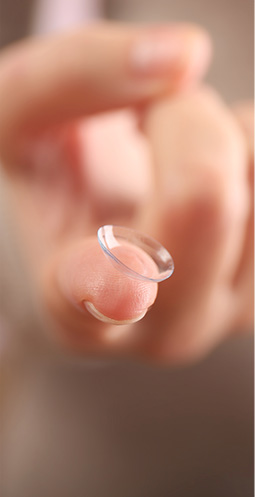We tend to only think about blinking once something affects it, so when each blink makes you wince, you’ll probably start thinking about it a lot! It’s a seemingly trivial motion, but pain when blinking can greatly impact your day-to-day life. Eye pain when blinking can stem from various causes, ranging from environmental factors to underlying health issues.
Whether you’re a student scrolling through endless reading materials, an office worker staring at screens all day, or simply someone who enjoys a good book in the evening, painful blinking can be a real damper. Fortunately, your optometrist can put you on the road to relief with an eye exam.
Common Causes of Eye Pain When Blinking
Eye Infections
Infections like conjunctivitis (commonly known as pink eye) can make your eyes sore and sensitive, especially when you blink. This is because the inflammation affects the delicate membranes lining the eyelids and covering the white part of the eyes called the conjunctiva.
These infections can be highly contagious (if they are of the viral variety) and easily spread in crowded places or through direct contact with infected surfaces. Along with soreness, you might notice:
- Redness in the white of the eye or inner eyelid
- Increased tearing
- burning sensation
- Gritty feeling in the eye
- Sensitivity to light
- Eyelid swelling
- Crust forming on the eyelids or lashes, especially when waking up
Bacterial infections often require antibiotic treatments in the form of eye drops or ointments to clear up effectively. Viral infections typically resolve on their own between 7 days to a few weeks. In the meantime, prevent the spread with good hygiene practices such as washing your hands frequently, avoiding touching your eyes, and not sharing personal items like towels or makeup.
Eye Allergies
When allergens cause conjunctivitis, we call them allergic conjunctivitis. While this type isn’t contagious like its viral cousins, it can still be frustrating and cause symptoms including:
- Itchy eyes
- Redness in and around the eyes
- Watery or teary eyes
- Swollen eyelids
- Burning sensation in the eyes
- Sensitivity to light
Depending on the allergies, you may notice sneezing and a runny nose as well. Seasonal allergens like pollen or indoor allergens like dust mites can trigger these symptoms. Allergy medications containing antihistamines could help manage these symptoms but always consult with your healthcare provider for a tailored approach.
Dry Eyes
One of the most common culprits behind painful blinking is dry eyes. There are 2 general types of dry eye:
- Aqueous deficient dry eye: This type of dry eye occurs when the lacrimal glands don’t produce enough of the watery component of the tear film. The tear film is crucial for keeping the surface of your eyes moist, and when there’s insufficient quantity, the eyes can become dry and irritated.
- Evaporative dry eye: In contrast, evaporative dry eye is typically caused by inflammation of the meibomian glands, which affects the oily layer of the tear film. This oily layer is essential for preventing tears from evaporating too quickly.
When your eyes don’t produce enough tears, or the quality of tears is poor, the lubrication that normally allows eyelids to glide smoothly across the eye becomes inadequate. You can imagine how this friction can cause pain! Several factors contribute to dry eyes, including:
- Aging
- Prolonged screen time
- Air conditioning or heating
- Windy, hot, or dry conditions
- Certain medications
- Blepharitis

Alleviating dry eye discomfort depends on the cause, but with care and attention, you can find relief! You may be able to treat mild dry eye at home by using artificial tears or heated eye masks, but for stubborn cases, we can recommend:
- Intense regulated pulsed light (IRPL) therapy: Use precision light pulses to melt away blockages in meibomian glands to reduce inflammation and restore tear quality.
- Jett Plasma Pen: A tool used for treating meibomian gland dysfunction (MGD), blepharitis, demodex, chalazion, and can also be used to reduce fine lines and wrinkles.
- Meibomian gland expression: After heating the eye area, your optometrist will manually squeeze your eyelids to drain the glands.
- Blephex eyelid cleaning: Clean and exfoliate the eyelids to remove irritating debris.
Foreign Bodies
Small particles such as dust, sand, or debris can become trapped under your eyelid, leading to discomfort with every blink. You can imagine how when these foreign particles rub against the eye’s sensitive surface, they could cause redness and even minor abrasions if not addressed promptly. Typically, tears should be able to wash away minor irritants, but you can help the process along.
If debris gets into your eye, rinse it thoroughly with clean water or a saline solution to effectively flush out any foreign bodies. In doing so, you could not only relieve the irritation but also prevent potential eye infections or further complications. If the irritation persists, contact your optometrist immediately for further assessment and treatment.
Improper Contact Lens Usage
Contact lenses offer freedom and convenience for many people, but improper use could lead to dry eye, discomfort, and even more serious conditions like infections. To help avoid these issues, follow proper hygiene for lens care, such as:
- Wash your hands before handling lenses
- Use the right cleaning solution, never tap water.
- Only wear them for the intended duration.
- Avoid sleeping in lenses.
- Clean your storage case and replace every 3 months
You can always talk to your eye care professional for guidance tailored to your specific needs.
When to Seek Professional Help
While some causes of eye pain when blinking can be managed at home, others might require professional attention. Persistent pain, changes in vision, or any signs of infection warrant a visit to an optometrist. For example, scratches or ulcers on the cornea can cause significant discomfort and generally won’t get better on their own. They need to be diagnosed and treated promptly to prevent further complications.
A rarer, but much more severe cause of eye pain is glaucoma. This condition involves an increase in eye pressure, leading to nerve damage. Although the most common types of glaucoma involve no pain and generally have no early symptoms, angle-closure glaucoma is a rare type of glaucoma that can cause severe eye pain and rapid vision loss if not treated promptly.
Take the Next Step Toward Comfortable Vision
Your eyes are vital for so many daily activities, and ensuring they’re in the best shape possible is crucial. If you’re experiencing persistent eye discomfort, or simply want to keep your eyes healthy, now is the perfect time to act!
At Stoney Creek Eye Care, our dedicated team of professionals is ready to provide personalized, comprehensive eye care services to keep your eyes feeling great. Book an appointment with us today and take a proactive step towards clearer, more comfortable vision. Your eyes deserve nothing less than the best care!









